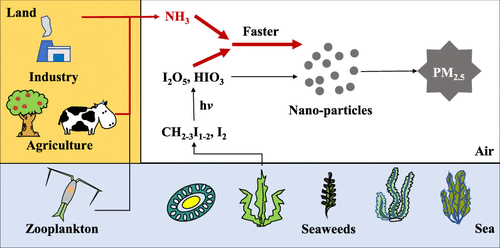当前位置:
X-MOL 学术
›
Environ. Sci. Technol.
›
论文详情
Our official English website, www.x-mol.net, welcomes your feedback! (Note: you will need to create a separate account there.)
Formation Mechanisms of Iodine-Ammonia Clusters in Polluted Coastal Areas Unveiled by Thermodynamics and Kinetic Simulations.
Environmental Science & Technology ( IF 11.4 ) Pub Date : 2020-06-26 , DOI: 10.1021/acs.est.9b07476 Deming Xia 1 , Jingwen Chen 1 , Huan Yu 2 , Hong-Bin Xie 1 , Ya Wang 1 , Zhongyu Wang 1 , Tong Xu 1 , David T Allen 3
Environmental Science & Technology ( IF 11.4 ) Pub Date : 2020-06-26 , DOI: 10.1021/acs.est.9b07476 Deming Xia 1 , Jingwen Chen 1 , Huan Yu 2 , Hong-Bin Xie 1 , Ya Wang 1 , Zhongyu Wang 1 , Tong Xu 1 , David T Allen 3
Affiliation

|
It has been revealed that iodine species play important roles in atmospheric new particle formations (NPFs) in pristine coastal areas. However, it is unclear whether other atmospheric species, such as NH3, for which the levels in coastal areas of China are >2.5 × 1010 molecules·cm–3 are involved in the NPFs of iodine species, although NH3 has been proved to promote particle formation of H2SO4. Via high-level quantum chemical calculations and atmospheric cluster dynamic code simulations, this study unveiled new mechanisms of nucleation, in which NH3 mediates the formation of iodine particles by assisting hydrolysis of I2O5 or reacting with HIO3. The simulated formation rates of iodine–ammonia clusters via the new mechanisms are much higher than those simulated via sequential addition of HIO3 with subsequent release of H2O, under the condition that NH3 concentrations are higher than 1010 molecules·cm–3. The new mechanisms can well explain the observed cluster formation rates at a coastal site in Zhejiang of China. The findings not only expand the current understandings of the role of NH3 in NPFs but also highlight the importance of monitoring and evaluating NPFs via the iodine–ammonia cluster pathway in the coastal areas of China and other regions worldwide.
更新日期:2020-08-04


























 京公网安备 11010802027423号
京公网安备 11010802027423号